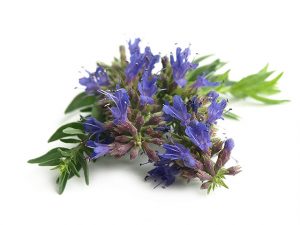
Hyssop — sources, health benefits, nutrients, uses and constituents at NaturalPedia.com
Wednesday, October 25, 2017 by Michelle Simmons
http://www.naturalpedia.com/hyssop-sources-health-risks.html

Hyssop, scientifically referred to as Hyssopus officinalis, is an evergreen garden herb from the mint family Lamiaceae. It has a short and fibrous rhizome. Its stalk comes out from a woody base and divides into a number of erect square and branching stems that may grow up to two feet or 61 centimeters. The small leaves do not have stems and are lance-shaped, with fine hairs and smooth edges. Its flowers have a tubular, two-lipped corolla, and four stamens. Their bloom may be in colors of rose, purple, mauve, blue, and white. The most widely used part of the plant is its flower-tops, which are used for medicinal and decorative purposes.
The plant has a sweet scent and a warm bitter taste, which has been used for a long time as a flavoring agent for foods and beverages. It is grown for its fragrant leaves and flowers. It is also used as a folk medicine. The plant is commonly grown in areas from southern Europe eastward to Central Asia; it has become naturalized in North America.
Hyssop is also known as curdukotu, hastipoppili, hisopo, and yanagi-hakka.

List of known nutrients
An article in Herbs-Herbal-Supplements.Knoji.com has listed the essential nutrients that hyssop contain. Hyssop provides:
- Caffeic Acid
- Camphene
- Glycosides
- Hyssopin
- Limonene
- Monoterpenols
- Oleanolic Acid
- Pinanones
- Rosmarinic Acid
- Sabinene
- Sesquiterpenols
- Tannins
Medicinal uses for hyssop
There are several medicinal uses for hyssop. The plant is known for its volatile oil and other ingredients that are found in the leaves and stems. Hyssop contains astringent properties that can treat wrinkles, sagging skin, loose muscles, and prevent hemorrhage by constricting blood vessels. Since it has antispasmodic properties, it can relieve common cold, bronchitis, catarrh, and asthma. The plant is also used as a natural treatment for colic, abdominal cramps, and flatulence. Moreover, it can be a natural remedy for bruises, insect bites, and muscle pain. It also has the ability to cure wounds and prevent infections.
However, hyssop also has side effects. Its essential oil contains pino-camphone, a ketone known to cause convulsions and seizures when taken in high amounts. This compound triggers the nerves and can be dangerous for people suffering from epilepsy, and pregnant women.
Body systems supported by hyssop
There are several body systems that hyssop supports. One of these is the digestive system. It can cure flatulence; relieve heaviness, indigestion, and nausea; improve digestion; and prevent stomachache by catalyzing synthesis of digestive juices and enzymes. It is beneficial for women because it can regulate menstruation cycle and alleviate premenstrual syndrome. The plant also supports the cardiovascular system as it can improve and enhance the circulation of blood. Its oil helps prevent arthritis, rheumatism, and gout. Hyssop herb oil supports the skin. It can cure and prevent skin diseases such as eczema, dermatitis, and psoriasis. Moreover, it moisturizes the skin. It supports the respiratory system as it has protective effects against respiratory diseases such as bronchitis and tonsillitis. It also helps prevent diseases including cold, flu, cough, and fever.
Ways to use hyssop
Hyssop plant can be used in several ways. Freshly cut tops of the mature hyssop plant will make a good ingredient for salads, soups, or teas. The plant’s leaf and flowers can also be used to make hyssop tea. Hyssop can also be used as an oil. Its essential oil is produced by steam distillation of its flowering tops.
Where to learn more
- Juice For Better Digestion – How to Make This Simple Juice to Boost Your Gut Health
- 10 Herbs that Boost Lung Health
- 16 Herbs and Spices That Can Fights Diabetes
- 10 Great Herbs and Whole Foods to Heal Your Gut Naturally
- The 4 Best Herbal Cleaning Recipes You Should Try
Summary
Hyssop (Hyssopus offiinalis) is a plant belonging to the Lamiaceae family. The plant’s flower-tops are the most widely used part. Hyssop has been used for medicinal and decorative purposes. The plant is also known for its oil that has several medicinal uses. It supports the skin, digestive system, and respiratory system. However, it contains the compound known as pino-camphone, which causes convulsions and seizures when taken in high dosages.
Sources include:
Tagged Under: Tags: hyssop





